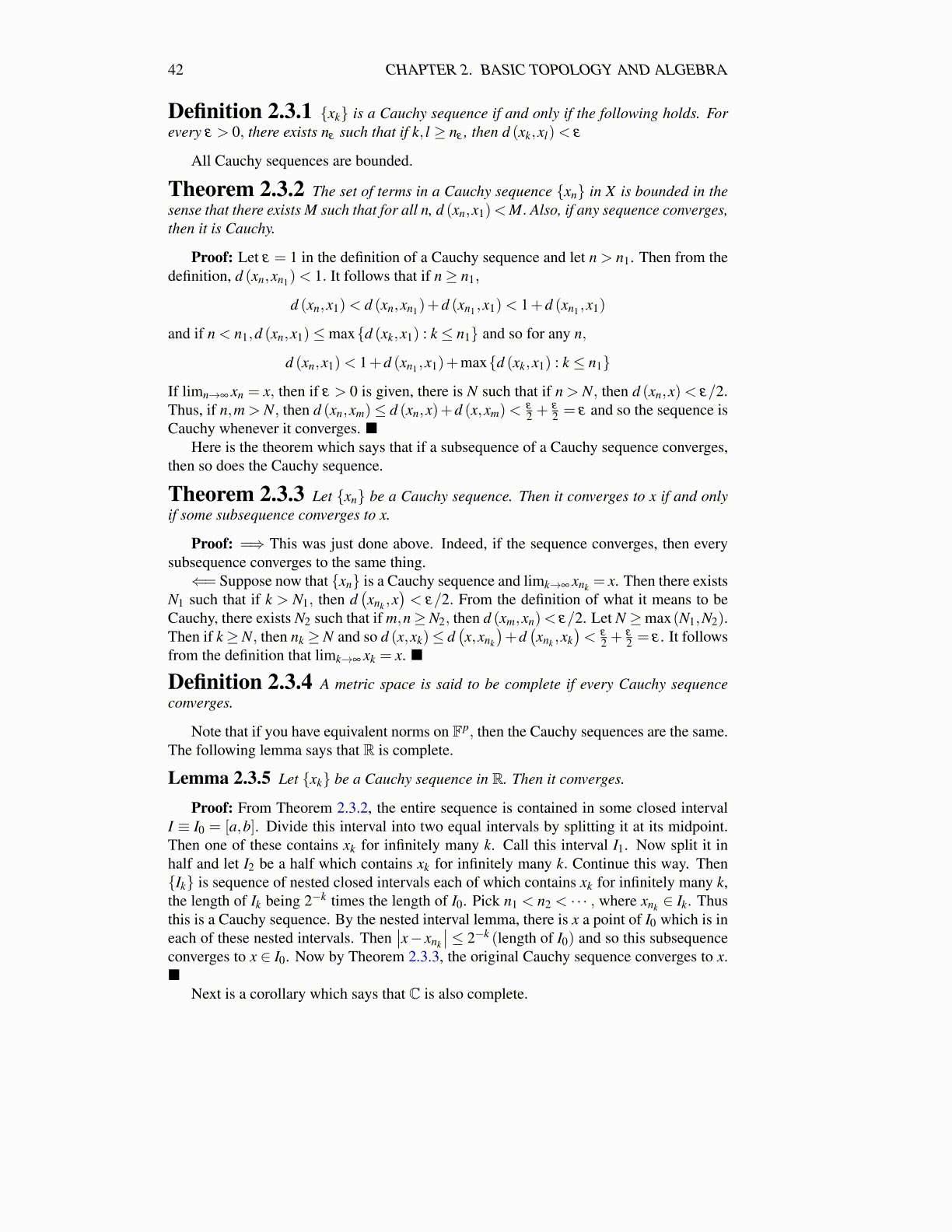
42 CHAPTER 2. BASIC TOPOLOGY AND ALGEBRA
Definition 2.3.1 {xk} is a Cauchy sequence if and only if the following holds. Forevery ε > 0, there exists nε such that if k, l ≥ nε , then d (xk,xl)< ε
All Cauchy sequences are bounded.
Theorem 2.3.2 The set of terms in a Cauchy sequence {xn} in X is bounded in thesense that there exists M such that for all n, d (xn,x1)<M. Also, if any sequence converges,then it is Cauchy.
Proof: Let ε = 1 in the definition of a Cauchy sequence and let n > n1. Then from thedefinition, d (xn,xn1)< 1. It follows that if n≥ n1,
d (xn,x1)< d (xn,xn1)+d (xn1 ,x1)< 1+d (xn1 ,x1)
and if n < n1,d (xn,x1)≤max{d (xk,x1) : k ≤ n1} and so for any n,
d (xn,x1)< 1+d (xn1 ,x1)+max{d (xk,x1) : k ≤ n1}
If limn→∞ xn = x, then if ε > 0 is given, there is N such that if n > N, then d (xn,x)< ε/2.Thus, if n,m > N, then d (xn,xm)≤ d (xn,x)+d (x,xm)<
ε
2 +ε
2 = ε and so the sequence isCauchy whenever it converges. ■
Here is the theorem which says that if a subsequence of a Cauchy sequence converges,then so does the Cauchy sequence.
Theorem 2.3.3 Let {xn} be a Cauchy sequence. Then it converges to x if and onlyif some subsequence converges to x.
Proof: =⇒ This was just done above. Indeed, if the sequence converges, then everysubsequence converges to the same thing.⇐= Suppose now that {xn} is a Cauchy sequence and limk→∞ xnk = x. Then there exists
N1 such that if k > N1, then d(xnk ,x
)< ε/2. From the definition of what it means to be
Cauchy, there exists N2 such that if m,n≥N2, then d (xm,xn)< ε/2. Let N ≥max(N1,N2).Then if k≥N, then nk ≥N and so d (x,xk)≤ d
(x,xnk
)+d(xnk ,xk
)< ε
2 +ε
2 = ε . It followsfrom the definition that limk→∞ xk = x. ■
Definition 2.3.4 A metric space is said to be complete if every Cauchy sequenceconverges.
Note that if you have equivalent norms on Fp, then the Cauchy sequences are the same.The following lemma says that R is complete.
Lemma 2.3.5 Let {xk} be a Cauchy sequence in R. Then it converges.
Proof: From Theorem 2.3.2, the entire sequence is contained in some closed intervalI ≡ I0 = [a,b]. Divide this interval into two equal intervals by splitting it at its midpoint.Then one of these contains xk for infinitely many k. Call this interval I1. Now split it inhalf and let I2 be a half which contains xk for infinitely many k. Continue this way. Then{Ik} is sequence of nested closed intervals each of which contains xk for infinitely many k,the length of Ik being 2−k times the length of I0. Pick n1 < n2 < · · · , where xnk ∈ Ik. Thusthis is a Cauchy sequence. By the nested interval lemma, there is x a point of I0 which is ineach of these nested intervals. Then
∣∣x− xnk
∣∣≤ 2−k (length of I0) and so this subsequenceconverges to x ∈ I0. Now by Theorem 2.3.3, the original Cauchy sequence converges to x.■
Next is a corollary which says that C is also complete.